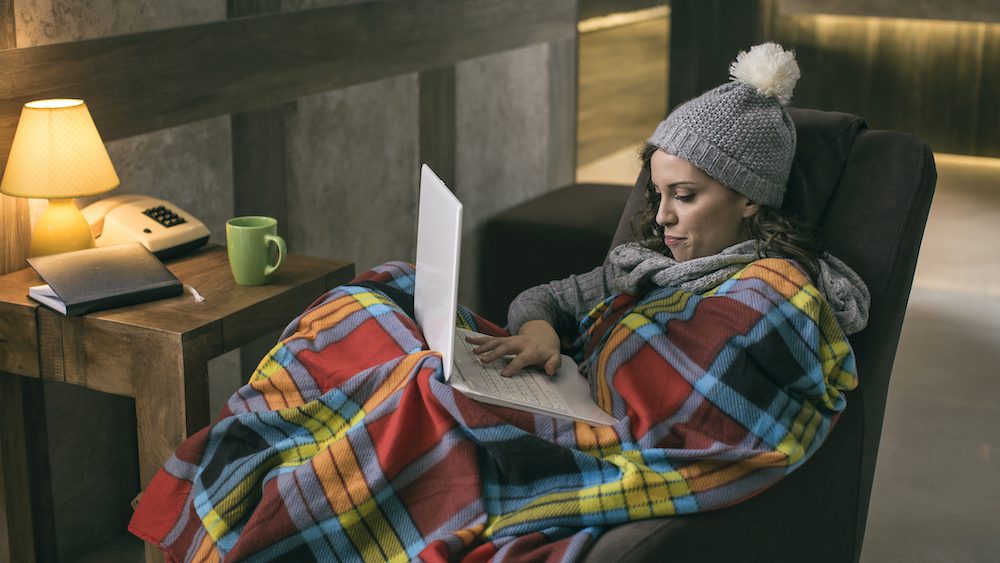
hoozone/Getty Images
As the cooler weather sets in and people continue to work from home, keeping your home warm throughout the day has never been more necessary. But continuously running the heater can rack up a big heating bill.
The U.S. Energy Information Administration projected that most U.S. consumers will spend more to heat their homes this winter than last year, as more people remain home to work and attend school due to the coronavirus.
Keeping the heating bill down without sacrificing warmth is possible, though.
“Energy-efficient home upgrades can really add up and have a big impact on your family budget,” says New Jersey–based celebrity home improvement expert Anthony Carrino.
Bundling up in a blanket works for those days when you don’t have meetings, but when it comes time to look professional on a Zoom call, you’ll want to make sure your house doesn’t feel like an icebox. Here are some tips from design and home improvement experts on how to prep your house so you can stay comfortable at home throughout the day.
Seal up your home
Cold air can seep into your home through cracks and small openings.
“Insulate windows and doors with weatherstripping and caulking,” says Carrino. A simple way to check the heating loss of your window insulation is to light a candle and slowly move it around the edges of the window. If the candle flickers, it means outside air is penetrating that area.
Carrino says a DIY fix for air seeping in through your windows is to take a razor knife and cut the bead of caulking, and then gently remove the trim with a small pry bar.
“With the trim off, you can use a can of Great Stuff expanding foam ($3.78, Home Depot) and seal around your windows. Let the foam set, cut off any excess that expanded too far, and replace your trim,” says Carrino.
He says homeowners can also consider replacing old windows. And be sure to use the sun to your advantage.
“Capture natural heat by opening curtains on south-facing windows during the day and closing them when the sun goes down to keep the warmth inside,” Carrino says.
Ensure your heating system works
Experts recommend homeowners test their heater in advance of the colder months each year, and consider scheduling a service check to confirm your heating system is running at its best.
“Keeping your furnace clean, lubricated, and properly adjusted can save about 5% on heating costs,” says Breegan Jane, an interior designer in Los Angeles. “An HVAC pro can assess your system, suggest any repairs it might need, and make sure you are ready before the coldest temps arrive.”
Replace your furnace filter
Regularly changing the air filter in your furnace can extend the life of your heating system and prevent dust, dirt, mold spores, and allergens from circulating in the air in your home.
“A dirty HVAC filter restricts airflow and increases energy usage as your system works harder to push air through it,” says Carrino. “Replace or clean filters every season. And when the system is being used most, you might want to inspect your filters once a month to ensure that air can pass through freely, especially if you have pets.”
Carrino says newer homes typically have less air leak or less air being changed over from outside to inside, which makes the home run more efficiently. However, it does mean homeowners should still be diligent with their filters “to make sure they have good, safe indoor air quality, especially with how much time we are all spending at home right now.”
Consider a multizone HVAC system
During the winter you may be spending more time in certain rooms than others. So why heat every room? A multizone system allows you to heat different parts of your house at different times, ultimately giving you more control over how much energy you’re using throughout the day.
“You have separate thermostats that control different temperature areas—for example, the upstairs and downstairs,” says Carrino. “That way, if your bedrooms are upstairs and you won’t be using them all day, you can lower that zone so it is running more efficiently, and keep the other zone, where you are working and living during the day, at an ideal comfort level.”
Set your thermostat at the right setting
The ideal room temperature has surely caused many a disagreement. Should it be set to a cozy 70 degrees or a more conservative 68?
“Agreeing on where to set the thermostat isn’t easy. But to save money, set it as low as possible while still maintaining a comfortable temperature, usually between 65 to 70 degrees,” says Jane.
If you aren’t home during the day, you can lower the temperature even more. And if your family can manage it, Jane says to lower the thermostat by 10 to 15 degrees at night to save even more on that utility bill.
“Compromise with the family by placing warm throw blankets on the couch, adding layers of bedding, and investing in fuzzy socks,” Jane says.
The post How To Stay Warm While Working From Home This Winter—Without Spending a Fortune on Heating appeared first on Real Estate News & Insights | realtor.com®.
No comments:
Post a Comment